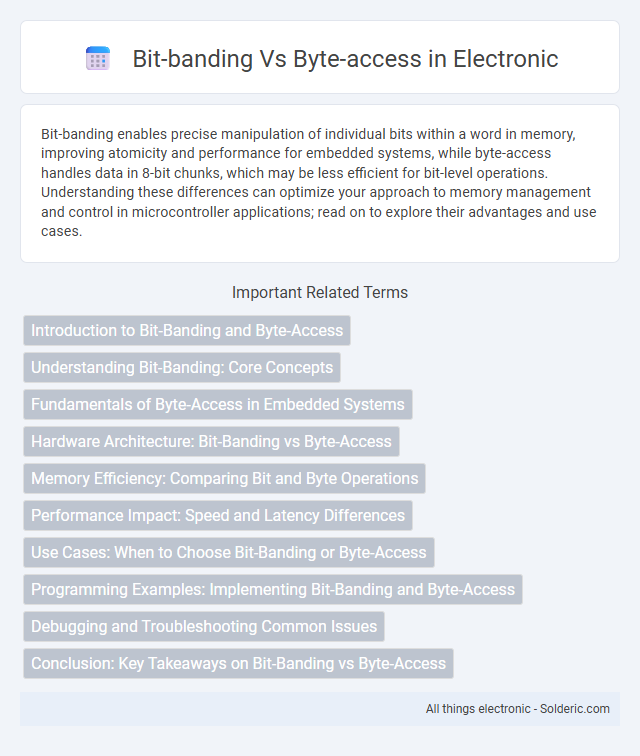Bit-banding enables precise manipulation of individual bits within a word in memory, improving atomicity and performance for embedded systems, while byte-access handles data in 8-bit chunks, which may be less efficient for bit-level operations. Understanding these differences can optimize your approach to memory management and control in microcontroller applications; read on to explore their advantages and use cases.
Comparison Table
| Feature | Bit-Banding | Byte-Access |
|---|---|---|
| Access Granularity | Single bit | Single byte (8 bits) |
| Memory Efficiency | Efficient for bit manipulation | Less efficient, accesses full byte |
| Performance | Faster atomic bit access | Slower bit manipulation requiring read-modify-write |
| Use Case | Control flags, hardware registers | General data storage and transfer |
| Hardware Support | Requires ARM Cortex-M bit-banding support | Universal support across most platforms |
| Complexity | Requires address calculation for bit access | Simpler direct byte addressing |
Introduction to Bit-Banding and Byte-Access
Bit-banding is a memory management technique primarily used in ARM Cortex-M microcontrollers that allows individual bits within a word to be accessed and manipulated directly, improving atomic operations and reducing code complexity. Byte-access refers to the traditional method of reading or writing data in 8-bit increments, which can be less efficient when only single bits need modification. Understanding these methods helps you optimize embedded system performance by choosing the most suitable approach for precise or bulk data manipulation.
Understanding Bit-Banding: Core Concepts
Bit-banding maps each bit of a memory region to a separate word address in a dedicated alias region, enabling atomic bitwise manipulation without the need for read-modify-write cycles. This technique significantly enhances real-time performance in embedded systems by allowing efficient bit-level access while maintaining atomicity in multi-threaded environments. Understanding bit-banding helps you optimize your firmware for precise and fast control over individual hardware register bits compared to traditional byte-access methods.
Fundamentals of Byte-Access in Embedded Systems
Byte-access in embedded systems refers to reading or writing data in 8-bit chunks, which aligns with the architecture of most microcontrollers and memory systems. This method simplifies handling of data types and peripheral registers but can be less efficient when manipulating individual bits within a byte. You can optimize control and memory usage by understanding when byte-access suits your application compared to alternatives like bit-banding.
Hardware Architecture: Bit-Banding vs Byte-Access
Bit-banding hardware architecture enables direct manipulation of individual bits in a dedicated memory region, mapping each bit to a word-sized alias address for atomic read-modify-write operations. Byte-access architecture processes data in 8-bit chunks, requiring additional masking and shifting to modify specific bits, which can increase instruction count and latency. Bit-banding improves performance and reliability in embedded systems by minimizing race conditions and enabling efficient bit-level control in peripherals and registers.
Memory Efficiency: Comparing Bit and Byte Operations
Bit-banding enables direct manipulation of individual bits within a memory word, offering superior memory efficiency for applications requiring fine-grained control without accessing entire bytes. Byte-access operations involve reading or writing full bytes, potentially leading to unnecessary memory usage when only specific bits need modification. Utilizing bit-banding reduces overall memory footprint and improves performance in embedded systems where optimizing resource usage is critical.
Performance Impact: Speed and Latency Differences
Bit-banding enables direct manipulation of individual bits in memory, reducing the number of instructions and memory accesses compared to byte-access, thereby improving speed and lowering latency. Byte-access requires mask and shift operations to isolate or modify bits, increasing execution time and processor cycles. Your embedded system's performance can significantly benefit from bit-banding in time-critical applications where rapid bit-level access is crucial.
Use Cases: When to Choose Bit-Banding or Byte-Access
Bit-banding is ideal for applications requiring atomic manipulation of individual bits in memory-mapped peripherals or SRAM, such as real-time control systems and embedded firmware dealing with flags or status bits. Byte-access is more efficient for general data handling where entire bytes or larger data units need to be read or written, like processing strings, numerical data, or bulk memory operations. Choosing bit-banding optimizes precise bit-level control and reduces interrupt-related synchronization issues, whereas byte-access maximizes throughput for standard data access patterns.
Programming Examples: Implementing Bit-Banding and Byte-Access
Bit-banding enables direct manipulation of individual bits in memory by mapping each bit to a separate word, requiring addresses and bit positions, such as `*(bit_band_base + (byte_offset * 32) + (bit_number * 4)) = 1;` to set a bit. Byte-access involves reading or writing entire bytes using standard pointers, like `uint8_t *ptr = (uint8_t *)address; *ptr = 0xFF;` to manipulate 8 bits simultaneously. Bit-banding is ideal for fine-grained control and atomic bit operations, while byte-access is simpler for standard data handling and buffer management.
Debugging and Troubleshooting Common Issues
Bit-banding simplifies debugging by allowing direct manipulation of individual bits in memory, reducing the complexity of isolating bit-level faults compared to byte-access methods. Byte-access requires masking and shifting operations to test or modify specific bits, often leading to increased debugging time and potential errors. Using bit-banding facilitates clearer fault detection and troubleshooting in embedded systems by enabling atomic bit operations without affecting surrounding bits.
Conclusion: Key Takeaways on Bit-Banding vs Byte-Access
Bit-banding allows atomic and efficient manipulation of individual bits by mapping each bit to a separate word address, improving performance in embedded systems with critical timing requirements. Byte-access handles data in 8-bit increments, offering simplicity but potentially requiring read-modify-write cycles for bit-level operations, which can introduce latency. Choosing bit-banding over byte-access enhances precision and reduces processor overhead in real-time applications where bit manipulation speed is crucial.
Bit-banding vs byte-access Infographic

 solderic.com
solderic.com